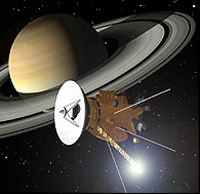 The Cassini-Huygens mission will begin its four-year tour around Saturn on Thursday - studying the planet and the many
moonsmoving under its influence. The Cassini-Huygens mission will begin its four-year tour around Saturn on Thursday - studying the planet and the many
moonsmoving under its influence.
The spacecraft will pass through a gap in Saturn's famous rings before making an engine burn to slow it down enough to enter an orbit around the gas giant.
The huge distance to the sixth planet means it takes 84 minutes for signals sent from the
probeto arrive at Earth.
The Saturn
orbit insertion(SOI) will mark the end of a seven-year journey across the Solar System for the bn spacecraft.
Mission scientists on Wednesday said the spacecraft was in excellent health and ready to carry out its crucial engine burn.
The only fly in the ointmentso far is a weather forecast that predicted high winds on Thursday at the radio
dishin Canberra, Australia, that will receive Cassini's
carrier signal.
If the
antennahas to be stowed away due to bad weather, mission scientists will not be able to monitor the spacecraft's progress during the burn.
Of course, this will not affect Cassini's performance; it will
act outa pre-programmed command sequence during the manoeuvre.
As it prepares to insert into Saturn's orbit, the probe will approach the planet from below the plane of its ring system and cross it through a large gap between the "F ring" and the "G ring".
Before passing through, Cassini will point its
high-gain antennain the direction of travel. This 4m-wide solid disc will shield the spacecraft's delicate components from any particles of debris it may encounter on the way through.
"This gap between the F and the G ring is very clear of debris. The Voyager and Pioneer spacecraft have already been through there," said Claudio Sollazzo, the
European Space Agency's (Esa) head of operations for the Huygens spacecraft, which is riding
piggybackon the main Cassini probe.
Dr Jeremy Jones, Cassini navigation team chief commented: "Something the size of a
marbleor a pea would do a lot of damage. We're just not expecting to see anything of that size."
When Cassini emerges above the ring plane, it needs to turn its main engine towards the direction of motion and fire it for 96 minutes. The resulting thrust will slow the spacecraft down by 640m/s - enough to be captured by Saturn's gravity.
The
manoeuvrewill use up about a third of the total
propellantwith which the spacecraft launched.
Cassini will then cross back below the ring plane - once again using the gap between the F and G rings - and turn its high-gain antenna towards Earth to transmit its new data to mission controllers.
"This is not a slam dunk by any means," Bob Mitchell, Cassini programme manager, told reporters in Pasadena, California.
"The spacecraft won't do anything tonight it hasn't already done in flight. But a 96-minute burn, where all systems have to work right for this amount of time, is a bit of a concern."
The burn will bring Cassini closer to Saturn than it will ever be again during its four-year tour. During the manoeuvre, the probe's distance from Saturn will be about 18,000km.
Cassini will use its
proximityto Saturn to take close-up photographs of the planet and its rings. But scientists stressed that Cassini will not be able to resolve individual ring particles and will be flying too fast to image large areas.
The spacecraft will gather scientific data for about an hour while it is above the ring plane.
It will measure the strength and direction of Saturn's
magnetic field. Small irregularities in this field will tell scientists about the planet's interior and core.
The probe may also be able to detect radio emission from lightning strikes in Saturn's atmosphere.
"We're about to
embark ona delicious
smorgasbordof scientific opportunities," said Dr Dennis Matson, Cassini project scientist.
In December, the spacecraft will release the Huygens probe into the thick atmosphere of Saturn's moon Titan.
Cassini will fly past Titan about 36 hours after orbit insertion, giving scientists a better view of this little-known world before Huygens is
despatched.
|
